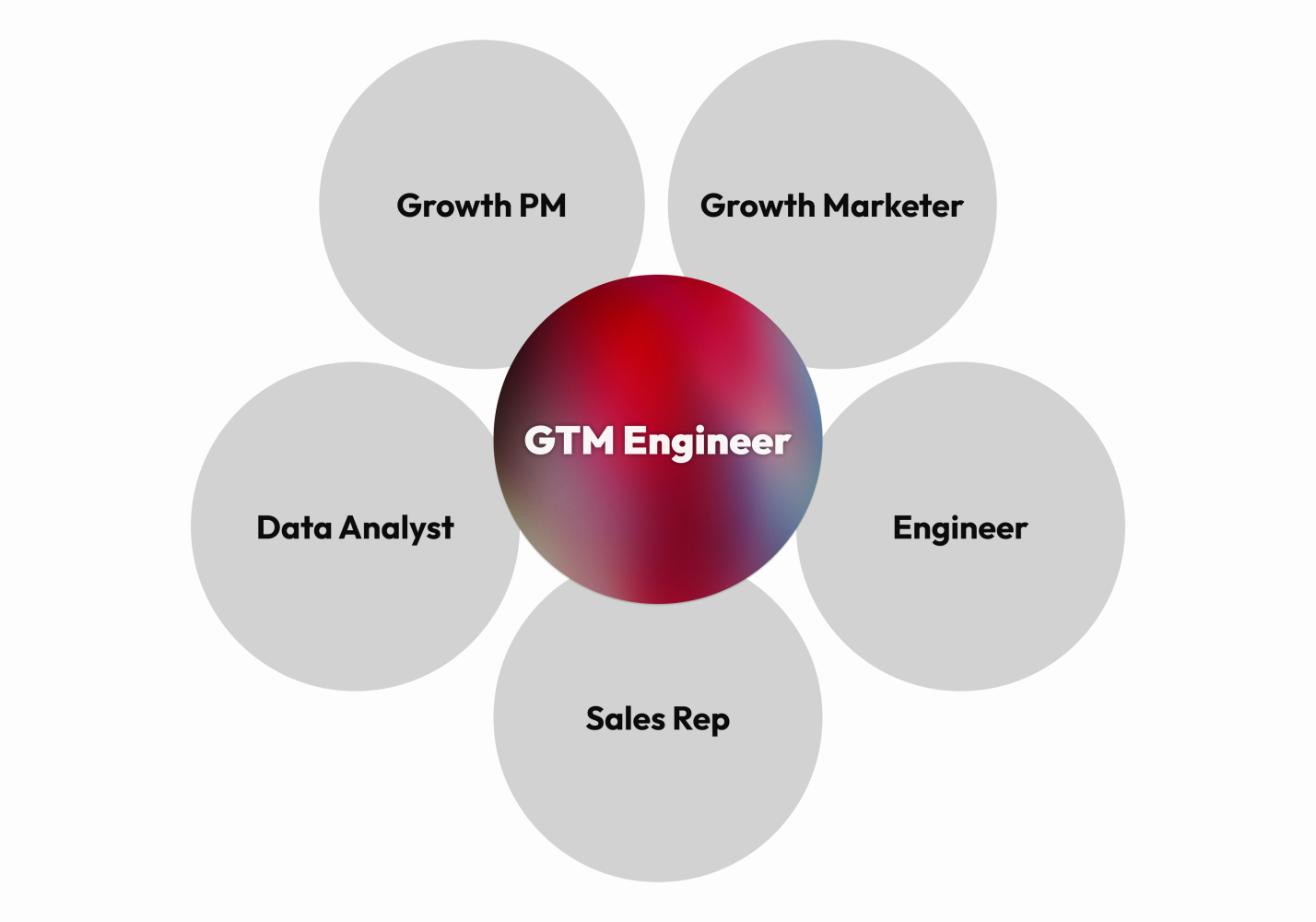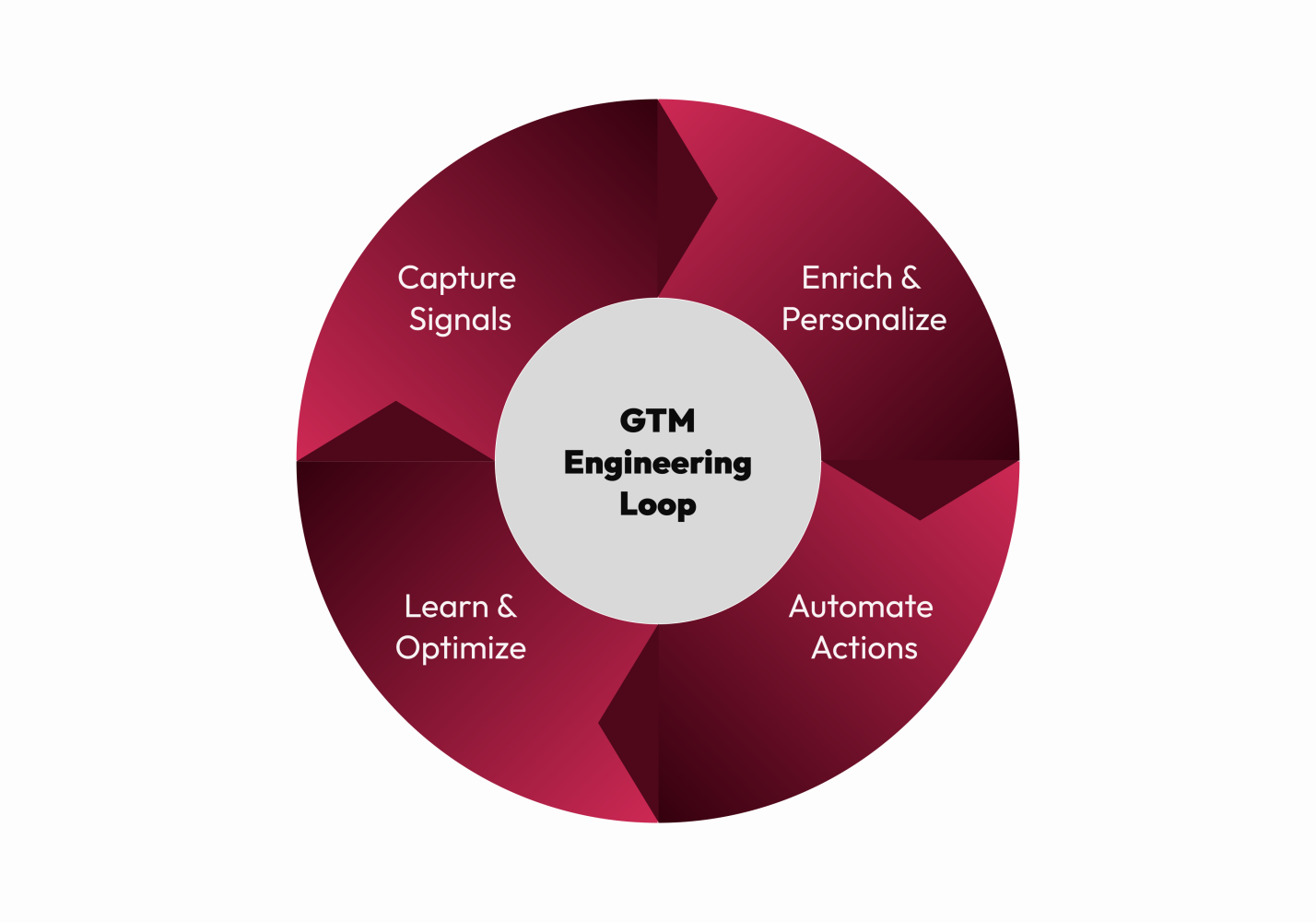TL;DR: GTM engineering scales your go-to-market like code – automated, personalized, and always on.
In 2025, APIs + no-code + AI make this possible in a way it wasn’t even 12 months ago.
Growth used to mean hiring your way through the funnel – more sales reps, more marketers, more engineers.
But piling on headcount doesn’t scale the way it used to. The more people you add, the more coordination overhead you create.
But what if growth wasn’t a headcount problem at all?
What if it were an engineering problem?
Take Snyk, for example – they didn’t scale to a $6-7 billion valuation by throwing bodies at the problem.
They found the right motion early on and scaled it through systems, not headcount.
This is the systems-first mindset at the heart of GTM engineering and how it solves this exact problem.

The default way of running growth teams
In traditional setups, driving growth was a team sport. You’d have a full-stack growth team with marketers, sales reps, data analysts, maybe a growth PM and an engineer, all juggling different pieces of the funnel.
There are different ways growth teams are structured, but below is how a product growth team might be structured:
- Growth PM: Prioritizes experiments, manages the growth roadmap, and aligns team efforts
- Growth marketer: Crafts campaigns, manages channels, runs A/B tests, and optimizes messaging.
- Engineer: Builds the tooling, landing pages, and integrations needed for growth experiments.
- Data analyst: Pulls insights from product and marketing data, informs decisions, and measures impact.
- Sales rep: Conducts outbound outreach, follows up on leads, and runs discovery calls.

We've built growth teams and engines repeatedly for our partners at Alt Ventures.
It worked, and it still does for many, but things are changing, and there's a problem with the above approach: It's built around individual effort rather than scalable systems.
What exactly is "GTM engineering"?
Think of it as the love child of a growth marketer and a software engineer.
Similar to software engineering, GTM engineering takes a systematic approach to designing, developing, testing, and maintaining GTM systems.
This could be designing automations, workflows, or data orchestration between different components of the GTM tech stack.

In plain English, GTM (Go-To-Market) engineering means applying an engineer’s mindset to sales and marketing, instead of siloed teams manually grinding out tasks. GTM Engineering's core capabilities include:
- Custom data sourcing & enrichment
- AI prompt engineering
- Automating manual processes
- Building workflows between disparate tooling
- Using SynthAI and GenAI to automate manual research (for sales reps)
- Content at scale (such as personalized emails or even videos)
Here's how the old way of growth compares to the GTM Engineering way in a sales context:

GTM isn’t one-size-fits-all.
If you’re B2C, you’re chasing users. If you’re B2B or enterprise, it’s all about deals and pipeline.
Account-based marketing is still one of the best plays in B2B, but scaling it by hand is slow and painful.
GTM Engineering makes these motions actually scale, whether you’re running PLG, ABM, or anything in between — automating the research, enrichment, and personalized outreach that would normally take a whole team.

The GTM Engineering Principles
What really sets GTM Engineers apart is how they approach growth problems, all while the fundamentals of growth stay the same.
Just as a software engineer writes code once and lets it run millions of times, a GTM engineer designs growth processes that can execute 24/7, without hand-holding.
Key elements of GTM engineering include:
- Personalization at scale: “Automation” doesn’t mean blasting generic spam. A GTM engineer uses data and AI to keep the human touch. The outreach and campaigns coming out feel hand-crafted for each recipient.
- Engineer’s mindset for growth: Design repeatable processes for acquiring and converting customers, similar to how engineers design scalable apps. It’s all about architecture.
- Automation at every step: Whenever there’s a manual task slowing things down, find a way to automate it. Data entry, lead qualification, email sending – you name it, use tools or scripts so it happens automatically in the background.
- Continuous improvement: Just like any good engineer, measure everything. Track how the automated workflows perform – open rates, response rates, conversion rates down the funnel – and iterate.

Real-World GTM engineering playbooks
Let’s peek into what GTM Engineering means in the real world. It’s not about any single magic tool; it’s about the mix and how they’re wired together.
Here are a few real-world combos GTM engineers are using to drive growth:
1. Social listening + outreach automation:
Problem: Sales teams manually monitor social media platforms to identify potential leads, a process that is time-consuming and prone to missed opportunities.
Tools Used: Social Listening Platforms (e.g., Brandwatch, Sprout Social) & Automation Tools (e.g., Zapier, HubSpot) & Cursor
How It Works:
- Social listening tools monitor social platforms for keywords or phrases indicating potential interest in a product or service.
- When such a mention is detected, it gathers relevant information about the person who posted it.
- Trigger a personalized outreach email to the prospect, referencing their specific comment and any publicly available data about them.
- Email is written based on the above context + your learnings database on what kind of emails got a reply and what didn’t.
2. Voice AI + content writing automation:
Problem: Getting what’s in your head onto paper takes too long, with too much explaining, too many briefs, and drafts that still miss your tone and structure.
Tools Used: Alt Voice & Cursor
How It Works:
- Have a natural conversation with an AI voice bot, like Alt Voice, to give it context on what you are thinking.
- Transcribe responses and analyze content for key themes.
- Cursor uses your interview transcript and does GPT Deep Research on the subject.
- Cursor then uses your previously written articles as a reference and understands your natural tone.
- The system takes those learnings and drafts a full article, ready for review and light polishing.
I actually used this exact process to help draft this article. The bot captured the key points, understood my usual tone and flow, and gave me a first draft that felt was 90% there – all I did was tweak, refine, and add my own final touches.
This isn’t fantasy; this is the kind of scalable system GTM engineers create. And the best part: it keeps running whether you’re asleep, on vacation, or focusing on strategy.

The Rise of GTM engineering as a role
Companies are realizing you can’t hire your way to hyper-growth. Adding headcount yields diminishing returns.
The smart play is to build systems that multiply output. If one engineer can automate what ten people used to do, that’s a game-changer for a lean team.
There’s also a tech explosion making this possible. Thanks to APIs, no-code tools, and AI, a growth marketer today can accomplish tasks that once required whole departments.
GTM engineering is riding that wave, turning growth ideas into automated workflows overnight.
The term took off thanks to Clay, a startup that collapsed its sales and ops roles into a single GTM engineer position. But you don’t need to work at Clay to use this idea.
How to start today
The basics are simple: build small workflows, learn to prompt well, and connect the dots between your tools. But like any craft, it takes practice (and a few failed automations) to get really good at it.
If you want to start playing with this today, here’s where I’d recommend:
- Clay University – the building blocks of automation and enrichment.
- OpenAI Prompt Engineering Guide – because good prompting is half the game.
- Anthropic Prompt Generator – get AI to write smarter prompts for you.
- GTM engineering Interview Bot – practice the skills and polish your thinking.
We’ve been building these kinds of growth systems & engines, even before AI made it cool.
If you’re thinking about how to bring this into your org or just want to discuss ideas, feel free to reach out. Cheers!
Uzair first shared this post on LinkedIn here.



 7 min read
7 min read
 Follow us on LinkedIn
Follow us on LinkedIn






